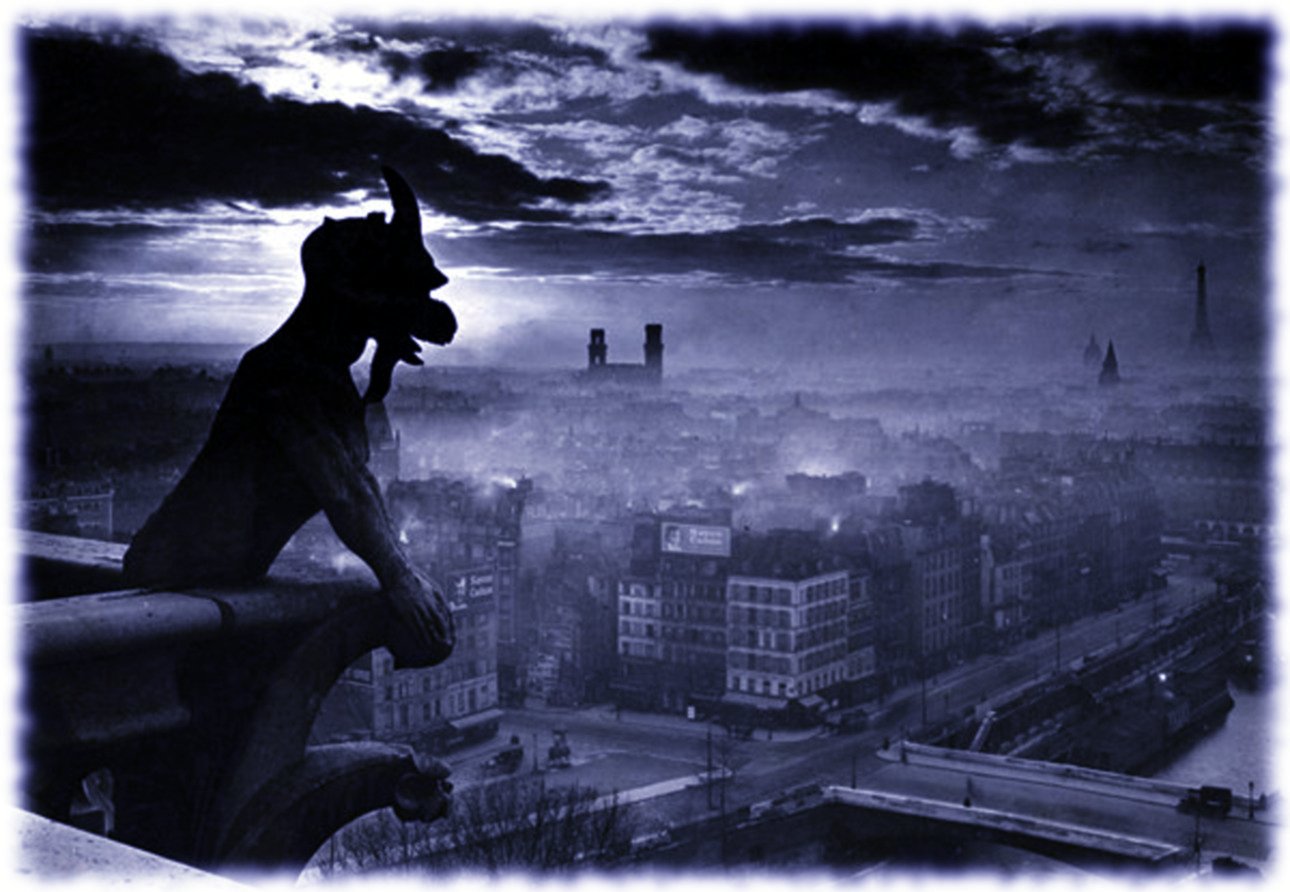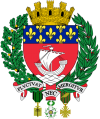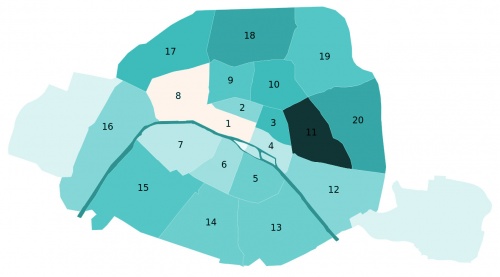Paris - La Belle Époque
- Past Imperfect -PLBE- Paris - 1933 -PLBE- Paris
Quote
In Paris, everybody wants to be an actor; nobody is content to be a spectator. -- Jean Cocteau
Paris during the Belle Époque
Appearance
[[]]
City Device
Climate
Paris has a typical Western European oceanic climate which is affected by the North Atlantic Current. The overall climate throughout the year is mild and moderately wet. Summer days are usually moderately warm and pleasant with average temperatures hovering between 15 and 25 °C (59 and 77 °F), and a fair amount of sunshine. Each year, however, there are a few days where the temperature rises above 30 °C (86 °F). Some years have even witnessed some long periods of harsh summer weather, such as the heat wave of 2003 where temperatures exceeded 30 °C (86 °F) for weeks, surged up to 39 °C (102 °F) on some days and seldom cooled down at night. More recently, the average temperature for July 2011 was 17.6 °C (63.7 °F), with an average minimum temperature of 12.9 °C (55.2 °F) and an average maximum temperature of 23.7 °C (74.7 °F).
Spring and autumn have, on average, mild days and fresh nights, but are changing and unstable. Surprisingly warm or cool weather occurs frequently in both seasons. In winter, sunshine is scarce; days are cold but generally above freezing with temperatures around 7 °C (45 °F). Light night frosts are however quite common, but the temperature will dip below −5 °C (23 °F) for only a few days a year. Snowfall is uncommon, but the city sometimes sees light snow or flurries with or without accumulation.
Rain falls throughout the year. Average annual precipitation is 652 mm (25.7 in) with light rainfall fairly distributed throughout the year. The highest recorded temperature is 40.4 °C (104.7 °F) on July 28, 1948, and the lowest is a −23.9 °C (−11.0 °F) on December 10, 1879.
Demonym
Parisian
Economy
Geography
Paris is located in northern central France. By road it is 450 kilometres (280 mi) south-east of London, 287 kilometres (178 mi) south of Calais, 305 kilometres (190 mi) south-west of Brussels, 774 kilometres (481 mi) north of Marseilles, 385 kilometres (239 mi) north-east of Nantes, and 135 kilometres (84 mi) south-east of Rouen. Paris is located in the north-bending arc of the river Seine, spread widely on both banks of the river, and includes two inhabited islands, the Île Saint-Louis and the larger Île de la Cité, which forms the oldest part of the city. The river’s mouth on the English Channel (La Manche) is about 233 mi (375 km) downstream of the city. Overall, the city is relatively flat, and the lowest point is 35 m (115 ft) above sea level. Paris has several prominent hills, of which the highest is Montmartre at 130 m (427 ft). Montmartre gained its name from the martyrdom of Saint Denis, first bishop of Paris atop the "Mons Martyrum" (Martyr's mound) in 250 A.D.
Excluding the outlying parks of Bois de Boulogne and Bois de Vincennes, Paris occupies an oval measuring about 87 km2 (34 sq mi) in area, enclosed by the 35 km (22 mi) ring road, the Boulevard Périphérique. The city's last major annexation of outlying territories in 1860 not only gave it its modern form but also created the twenty clockwise-spiralling arrondissements (municipal boroughs). From the 1860 area of 78 km2 (30 sq mi), the city limits were expanded marginally to 86.9 km2 (33.6 sq mi) in the 1920s. In 1929, the Bois de Boulogne and Bois de Vincennes forest parks were officially annexed to the city, bringing its area to about 105 km2 (41 sq mi). The metropolitan area of the city is 2,300 km2 (890 sq mi).
Arrondissements
Introduction
The city of Paris is divided into twenty arrondissements municipaux, administrative districts, more simply referred to as arrondissements. These are not to be confused with departmental arrondissements, which subdivide the 101 French départements. The word "arrondissement", when applied to Paris, refers almost always to the municipal arrondissements listed below. The number of the arrondissement is indicated by the last two digits in most Parisian postal codes (75001 up to 75020).
Paris during the Belle Époque
Population
- -- City (2,714,068) - 1901 census
- -- Urban (4,000,000) - 1905 census
Arenas
Attractions
- -- Casino de Paris -- The Casino located at 16, rue de Clichy, in the 9th arrondissement, is one of the well known music halls of Paris, with a history dating back to the 18th century. Contrary to what the name might suggest, it is a performance venue, not a gambling house.
Bars and Clubs
Cemeteries
City Government
Crime
The Apaches of Paris
[[]]
Apaches was a term that was introduced by Paris newspapers in 1902 for young Parisians who engaged in petty crime and sometimes fought each other or the police. They usually lived in Belleville and Charonne. Their activities were described in lurid terms by the popular press, and they were blamed for all varieties of crime in the city. In September 1907, the newspaper Le Gaulois described an Apache as "the man who lives on the margin of society, ready to do anything, except to take a regular job, the miserable who breaks in a doorway, or stabs a passer-by for nothing, just for pleasure.
Citizens of the City
Corax of Paris
Current Events
Fortifications
Galleries
Gallû of Paris
Cleaners
Vultures
Holy Ground
Hospitals
Hotels & Hostels
Landmarks
Law Enforcement
The Paris police force was completely re-organized after the fall of Napoleon III and the Commune; the sergents de ville were replaced by the 'Gardiens de la paix publique (Guardians of the Public Peace), which by June 1871 had 7,756 men, under the authority of the Prefect of Police, named by the national government. Following a series of anarchist bombings in 1892, the number was increased to 7,000 guardians, 950 sous-brigadiers and 80 brigadiers. In 1901, under the prefect Louis Lépine, in order to keep up with the technology of the time, a unit of policemen on bicycles (called the hirondelles after the brand of the bicycles), was formed, numbering 18 per arrondissement, and reaching 600 by 1906 for the whole city. A unit of river police, the Brigade fluviale, was organized in 1900 for the Universal Exposition, as well as a unit of traffic police, who wore a symbol of a Roman chariot embroidered on the sleeve of their uniform. The first six motorcycle policemen appeared on the streets in 1906.
In addition to the Gardiens de la paix publique (Gardiens de la paix, for short), Paris was guarded by the Garde républicaine (Republican Guard), under the military command of the Gendarmerie nationale. Gendarmes had been a particular target of the Commune; 33 had been taken hostages and were executed by a (Communard) firing squad on rue Haxo on May 23, 1871, in the last days of the Commune. In June 1871, they provided security in the damaged city. They numbered 6,500 men in two regiments, plus a unit of cavalry and a dozen cannon. The number was reduced in 1873 to 4,000 men in a single regiment, called the Légion de la Garde républicaine (Legion of the Republican Guard), with its headquarters on the quai de Bourbon, and the troops quartered in several barracks around the city. The Republican Guard was given the duty of providing security for the President of the Republic at the Élysée Palace, the National Assembly and the Senate, at the prefecture of police, and also at the Opéra, theaters, public balls, racetracks, and other public places. A unit of bicyclists was formed on June 6, 1907. When World War I began, the entire unit of Paris gendarmes was mobilized and fought at the front during war; 222 of them lost their lives.
By a decree of 29 June 1912, to assure the sûreté (security) of Paris by fighting organized crime (Apaches, bande à Bonnot), a criminal section called the Brigade criminelle was created.
Lupines of Paris
Bone Gnawers
Get of Fenris
Glass Walkers
Shadow Lords
Mages of Paris
Technocracy
Tradition
Celestial Chorus
Cult of Ecstasy
Electrodyne Engineers
Order of Hermes
Verbena
Mass Media
- Le Petit Journal
- Le Jounal
- Le Petit Parisian
- Le Matin
Monuments
Museums
Parks
Private Residences
Restaurants
Ruins
Schools
Shopping
Telecommunications
Theaters
Transportation
Vampires of the City
The Legacy of Villon: The Edicts
"The Edicts are written in English for understanding, and in French for mood purpose."
L'Art / The Art
Vous ne devrez ni voler, ni détruire, ni altérer un Objet d'Art sans l'Autorisation de l'Ancien parmi les Anciens. Aucun
Objet d'Art ne doit sortir du Territoire de France sans l'Autorisation de l'Ancien parmi les Anciens.
You must not steal, destroy, or alter an Object of Art without the Authorization of the Eldest among you.
No Object of Art is to exit the domain of France without the Authorization of the Eldest among you.
L'Elysée / The Elysium
Les Lieux protégé par l'Elysée ne pourront être le théatre de violence, ni de la Chasse. Provoquer la violence ou Chasser
dans l'Elysée sans l'Autorisation de l'Ancien parmi les Anciens est passible d'une Chasse de Sang. Par mesure de sécurité,
l'accès de certains Elysées sera réglementé.
Grounds protected by the Elysium will not be sullied by violence of hunt. Provoke violence or hunting in an Elysium
without the authorization of the Eldest among you can be punished by the Blood Hunt. For security reasons, the access to
some Elysiums will be limited.
L'Ordre / Order
L'ordre doit être garanti par le Prince, qui s'approprie donc de manière exclusive les moyens d'assurer
l'ordre et le bien-être de la Famille comme du Bétail. Il est par consécquent formellement interdit d'influencer
les forces de polices et les forces armées.
Les Masques et les Veilleurs, étant les representants du Prince, ne sont pas soumis à cet Edit.
Order is to be guarranteed by the Prince, who thus gather exclusively for himself the means to warrant the order and well
being of Kindred and Kine. Thus it is strictly forbidden to influence the police and army forces.
The Masques, being the representatives of the Prince, are not submitted to this Edict.
Diablerie / Diablerie
La Diablerie est un acte infâme indigne de notre Condition. Tout Caïnite convaincu de Diablerie sera passible d'une Chasse
de Sang, et ce, quel qu'ait été le Calice, ou l'endroit du crime.
Diablerie is an atrocious action under our condition. Any Kindred guilty of Diablerie can be Blood Hunted,
no matter who was the victim and where it happened.
L'Amaranthe / The Amaranth
Ceux qui se seront montré particulièrement indigne de leur Sang pourront voir leur Sang arraché par l'Amaranthe. Seuls
ceux qui auront été dignes des Traditions et Edits de Paris pourront se voir peut-être accordé par l'Ancien parmis les
Anciens, l'Amaranthe.
Those who acted in ways unworthy of their Blood can be subject to the Amaranth. Those who acted in ways worthy of their
Blood and of the Traditions and Edicts can be given the right of Amaranth by the Eldest among you.
La Magye / The Magick
Pratiquer les rituels magiques en présence d'un Mage est strictement interdit, tout comme tout contact avec eux.
Leur guerre d'ascension n'est pas la nôtre. Clan Tremere Le retour à Paris est conditionné par le comportement de leurs membres.
Les Veilleurs ne sont pas soumis à cet édit.
Praticing magic rituals in presence of a Mage is strictly forbidden, as is any contact with them. Their Ascensíon war is not our own. Clan Tremere Returning to
Paris is conditioned by the behaviour of their members.
The Veilleurs are not submitted to this Edict.
Assamites
Brujah
- -- Benedicte Dalouche -- Currently in Berlin...but wanting to return.
- -- L'Homme de Peu de Foi
- -- Saint Just 8th Generation, childe of Robin Leeland, sire of Karl.
- -- Thomas Frère(Thomas, Brother); 6th Generation Duc of the Brujah.
The Bâtards/ Catiff
Daughters of Cacophony
Followers of Set
- -- Theti-Sheri
- -- Samson Aersenns
Gangrel
- -- Niels Frank; - Progeny of Lord William Harper
- -- Jaques La Pul; - Childe of Niels Frank
- -- Jean-Luc Laupier - Progeny of Lord William Harper
Malkavian
Nosferatu
Toreador
- - Francois Villon -- Domain: The Louvre {Location: Right Bank of the Seine in the 1st arrondissement.}
- - Arnaud -- Domain: Club Elysée {Location: 8th Arrondissement}
- - Carla Gagnon -- Domain: Église de Saint-Nicolas-du-Chardonnet {Location: 5th Arrondissement}
- - Maxime -- Domain: Saint-Georges -- A neighborhood of Pigalle -- Maxime has a loft above the vaunted SACEM building that he uses as his haven. {Location: 9th Arrondissement}
- - Bernard -- Domain: The Louvre {Location: Right Bank of the Seine in the 1st arrondissement.} -- As the Seneschal of Paris, Bernard resides with his sire in the Louvre.
- - Chevalier d'Eglantine -- Domain: Les Invalides {Location: 7th Arrondissement}
- Merevith
- - Elle Emilie Nicoline
- - Lazlo Guerin -- Domain: Palais Bourbon {Location: 7th Arrondissement}
- - Florient (Deceased)
- - Versancia
- - Violetta Desjardins
- - Arnaud -- Domain: Club Elysée {Location: 8th Arrondissement}
Tremere
- -- Lazare Monet -- Creator of La Transsubstantiation de la Cuisine.
- -- Czere Ubireg -- Turkish Apprentice
True Brujah
Ventrue
Websites
https://en.wikipedia.org/wiki/Paris_between_the_Wars_(1919%E2%80%931939)
https://en.wikipedia.org/wiki/Belle_%C3%89poque
https://en.wikipedia.org/wiki/Paris_in_the_Belle_%C3%89poque


